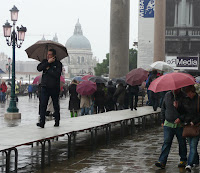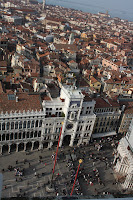
Forget about that high stakes poker game. Sadly, there is no Casino Royale in Montenegro as M intimated to Bond in a recent 007 movie.
There are however a lot of surprises when you are formally introduced to Kotor’s old town, a UNESCO World Heritage site, as well as the scenery beyond it.
The old medieval town of Kotor, a maze of winding cobbled streets, is encased within well preserved walls built in the 9th century. The walls meander up the side of a steep mountain to a fortress high on the hillside.
 Outside the walls the locals had brought their produce to town to sell and gossip in a makeshift market – there was an impressive display of chestnuts, olives, vegetables, fruit, flowers, cheese and cured ham.
Outside the walls the locals had brought their produce to town to sell and gossip in a makeshift market – there was an impressive display of chestnuts, olives, vegetables, fruit, flowers, cheese and cured ham.
Things didn’t get off to the best start that morning as the ship approached Kotor. Eating breakfast on the Terrace patio at the aft of the ship, the raindrops quickly turned to a raging torrent with the clouds sinking over the mountaintops and the wind whipping up white caps on the inlet, the southernmost fiord in Europe.
Prepared for the deluge we stepped ashore with umbrellas and rain gear to begin our drive along the old road to Cetinje.

As the old road snaked its way up the mountainside we realized it was going to be a drive of extreme hairpin bends with sheer drops and few barriers. Undoubtedly we had a good driver but there were a few moments when I truly wondered if this was going to be it.
As we climbed our ears popped and the weather began to change with blue sky appearing. Later sunshine lightened the valleys and brightened the deciduous trees that were changing colour in shades of yellow, lime and orange. This, against a backdrop of the limestone cliffs, blue sky, old stone buildings and curving roads was spectacular.

We broke our journey for a sample of home-made bread, cheese and smoked ham, served with honey wine and the local brew.

Seated on animal skins in a rustic cabin looking out on the colours of autumn, we did wonder why were eating (and drinking) so soon after breakfast.
At the highest point of our drive we were at 3500 feet and the weather had become noticeably cooler. The descent was equally thrilling, at one point the driver went to the very edge of the road before it dropped off into nothingness, reversing and making the turn into the next hairpin. Beautifully done we thought thankfully.
As we travelled on the other side of the mountain the beaches of the Budva Riviera came into view. Popular with Europeans and Russians it has become a high-priced summer resort where apparently the Serbian jet set come to be seen. At this time of the year it was quiet as the local residents prepared for winter with the town their own.

Things have changed since the breakup of Yugoslavia with three quarters of the old stone buildings of beautiful Kotor purchased by foreigners. In spite of all this I am still troubled by the fact that there is no Casino Royale in Montenegro.
 Our first stop was the Colosseum. It was pretty spectacular climbing the steps from the underground station to street level and seeing the walls of this famous amphitheatre reaching up skyward in front of us.
Our first stop was the Colosseum. It was pretty spectacular climbing the steps from the underground station to street level and seeing the walls of this famous amphitheatre reaching up skyward in front of us. 
 A sidewalk cafe served as a timely resting spot after the morning’s cultural assault, probably serving the best chocolate and strawberry gelato we have ever tasted anywhere.
A sidewalk cafe served as a timely resting spot after the morning’s cultural assault, probably serving the best chocolate and strawberry gelato we have ever tasted anywhere.


































 This couldn’t have been more so when we viewed the landscape from the walled hilltop village of San Gimignano. A golden glaze bathed the countryside in the late afternoon sun, church bells rang in the distance and we thought how wonderful to have shared those moments in time.
This couldn’t have been more so when we viewed the landscape from the walled hilltop village of San Gimignano. A golden glaze bathed the countryside in the late afternoon sun, church bells rang in the distance and we thought how wonderful to have shared those moments in time.









 In spite of the Bentleys, Ferraris and Aston Martins vying for position in Casino Square, the high priced real estate and the rarefied air taken in by the Monegasques, one unfortunate conclusion remained that day. No deep inhaling of that sea air recommended outside the Casino - the drains were making their presence felt. How awful for those poor people!
In spite of the Bentleys, Ferraris and Aston Martins vying for position in Casino Square, the high priced real estate and the rarefied air taken in by the Monegasques, one unfortunate conclusion remained that day. No deep inhaling of that sea air recommended outside the Casino - the drains were making their presence felt. How awful for those poor people!